Evade and strike back – hacking the corona virus effect in Helsinki Metropolitan Universities of Applied Sciences (3AMK), case virtual hackathon April 2020 from coaching point of view.
Background
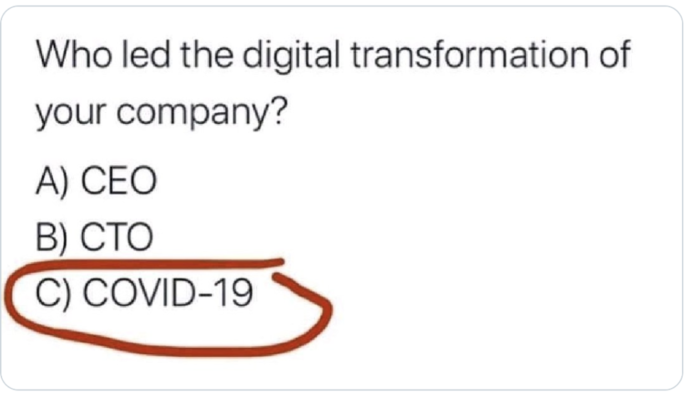 Meme rotating on the internet during corona lockdown in April 2020.
Meme rotating on the internet during corona lockdown in April 2020.
You have probably seen the meme that has been spreading around the internet in the spring of 2020. It ironically asks whether the digital transformation of your company has been led by the CEO, CTO or COVID-19. The joke couldn’t be more true – the virus has finally forced companies and organizations around the world to transform their work into the digital environment. This digital leap has been naturally easier for those who have been prepared and practiced that for a decade or two.
In March 2020, the strategic alliance of Haaga-Helia, Laurea and Metropolia – three biggest Universities of Applied Sciences in Helsinki metropolitan area in Finland – was planning a big event for students: bi-annual AI-Hackathon. In 2019 AI-hackathon 12 experts and 90 students took part and learned how to use artificial intelligence powered chatbots and robot in practice. As all the other events this year, the planning was interrupted by a nasty virus. Still, the organizers wanted to be innovative and arrange the event virtually.
This virtual hackathon was indeed possible because of the real transformation officer – COVID-19. However, the fast change of plans was feasible because the team was prepared. Luckily, this wasn’t the first time when the team organized a Hackathon or an online collaboration.
In the virtual AI-Hackathon, all three schools had common lectures, but otherwise the students worked in school-specific multi-disciplinary and multicultural teams to develop chatbots.
But how did it go in practice from Laurea’s & lecturers’ point of view? Sari Eestilä has interviewed Asko Mononen on the event and its background.
Schools out for the…quarantine
In Finland, the first COVID-19 infection was diagnosed at the end of January. Two months later, the government made quick decisions to carry out emergency law, close the schools and borders, and prohibit gatherings of more than ten people. As everywhere in Europe, uncertainty was great, and speculations spread. Adaptation was needed. The much-talked organizational agility was put to the test.
For Mononen and his colleagues, this was a challenge to “evade and strike back” – just as in aikido, the Eastern martial arts practice for self-defence, where you make use of the striker’s energy. “When attacked, first evade following the attacker’s energy and then strike back fast. Sounds easy, but like in martial arts, requires that it’s been practised for years, and being alert when the situation arises.”
Clearly, arranging an online hackathon was not an easy task. About 50 percent of the students from 20 courses dropped out from the Hackathon due to work or personal life burdens. Laurea had planned three other sessions around the hackathon, but the design was changed to virtual only option.
Plan B: everything online, save the hack!
The situation and pressure were perfect for new solutions!
Organizers in Haaga-Helia, Laurea and Metropolia had a lot to do in a short time. The course was built from scratch to Trello-collaboration platform. An alternative application (Zapier) was selected to shift the focus on robotic process automation. Zapier is a cloud service that makes it possible to automate using different apps, triggers and actions, and it gives thousands of options for the users. Google DialogFlow and strategic partner Headai’s Microcompetencies.com -platform and “skills to jobs”-APIs were also given as options for student projects.
At the end, the organizers decided to take the physical robot Pepper out of the option but keep the possibility to work on that virtually (human-robot interactions simulated on authoring software).
“Pepper -service robot was also an option with only the programming part without testing on physical robot and human interaction. We acknowledged the limitations, since issues usually rise in the testing phase. The robot doesn’t understand what people say because of the noise, or because we pronounce things wrong”, Mononen explains.
Hackathon partners Google and Headai were cooperative and agreed to do sessions online. Their lectures were the only thing that the three universities had in common. Unlike last autumn, Haaga-Helia, Laurea and Metropolia had no mixed teams between schools. Still, the idea was the same: to boost innovation and accelerate solution development focusing on robotic process automation, chatbots and competence-based AI.
Action oriented pedagogics – students first
Even online, teachers didn’t want to lose the main point and the customers of the Hackathon: the students. They wanted to support learning and make it challenging and fun, which was more demanding in the virtual environment.
“Even if we have several stakeholders, like customers, municipalities, general public and so on, we put the students first. Laurea’s service promise for students is: We are here for you at Laurea.”
Laurea has a strong learning by developing (LbD) background. It means that learning is authentic i.e. it’s not done separately from the working life, but together with real-life work projects and development assignments (see Figure 2 below). This way, students acquire important working life skills, such as entrepreneurship- and innovation skills. (More about LbD here: https://www.laurea.fi/en/laurea/laurea-as-a-university/#LbD or Raij & Taatila 2012).
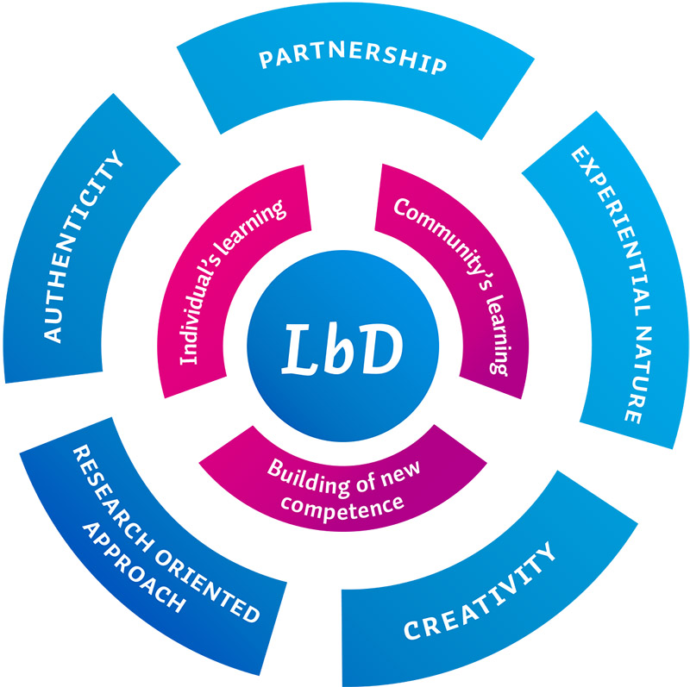 Figure 2: Laurea’s Learning by Developing model
Figure 2: Laurea’s Learning by Developing model
These working life meta-skills are at the core of Hackathon. In addition, it provides the 21st century competencies: communication, collaboration, critical thinking and creativity. Behind these competencies there are four forces: knowledge work, thinking tools, digital lifestyles and learning research (Trilling & Fadel 2009). In addition to meta-skills, the students’ experiences evolved from BusinessLab elements and way of working were described in see figure 3 below.
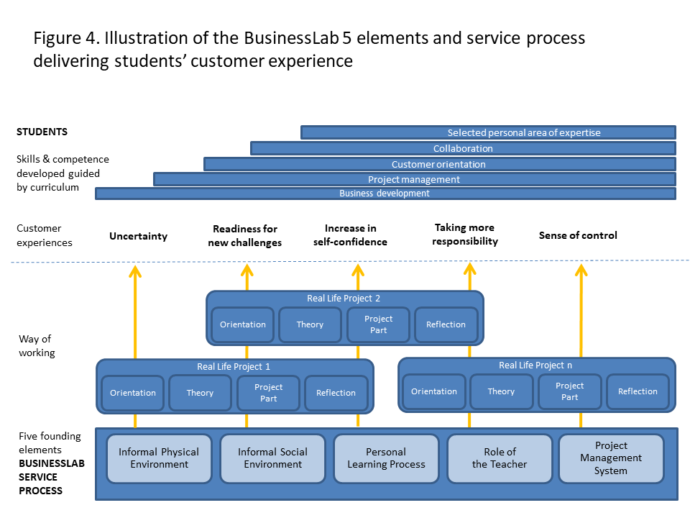 Figure 3: Students’ experiences and meta-skills delivered by BusinessLab elements and way of working
Figure 3: Students’ experiences and meta-skills delivered by BusinessLab elements and way of working
Partners’ support
Mononen was an architect of the virtual Hackathon, but he didn’t work alone. PhD Sumatra Saha, a technology expert from Google, introduced the use of Google DialogFlow and Firebase platforms. HeadAI’s software engineer Antti Koivisto taught the students about skills-based AI and displayed Headai’s custom Microcompetencies.com -platform. Students could see the functionality and use cases for these platforms in practice.
“We had a great combination of experts available: all coaches had several years of business development and agile project management experience. In addition, having deep knowledge of experienced tech people on board really helped students to proceed with their work.”
Schedule & coaching
Hackathon started with a few words from coaches and presentations from Saha and Koivisto. After that, the students worked in teams.
Students had a couple of hours to design a chatbot. They worked in Zoom breakout rooms, and the senior lecturers and Headai expert were on chat for technical questions. In addition, they had a short development meeting in slack time. At the end of the day, students presented their chatbot prototypes. All of them were able to go much further from the “fall back plan”, which was the concept presentation on paper. Students followed predefined steps and proceeded from problems to ideas, from ideas to solution concepts and from solution concepts to demo.
To make the day work, the support from coaches was critical. All Universities of Applied Sciences had up to four coaches that were available the whole time. At Laurea, the coaches had diverse backgrounds, such as business and AI, IT, chatbot development, and robotics.
According to Mononen, full availability of support is the key here.
“In the fast paced work, the support has to be available all the time. It does not help much if students get stuck and answer arrives with delay of hours or days.”
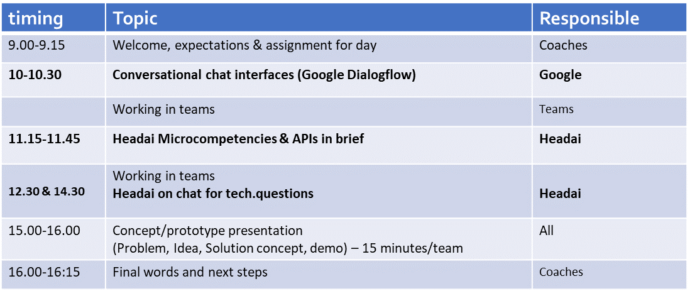 Table: Virtual hackathon agenda for 1.4.2020
Table: Virtual hackathon agenda for 1.4.2020
Welcome to post-LMS era for tech choices –working life tools for learning!
Aim of the education is to prepare students for working life. However, we still widely use tools with look and feel from the last century. Why aren’t we using the best practice tools that are used by companies today? Virtual hackathon was a practical demonstration that it can be done easily.
In education, the often-used traditional Learning Management Systems (LMS)-approach does not fully support virtual teams. For example, LMS discussion forums often lack topical referencing (#hashtags, like in Twitter or Slack) or ability to point messages to @individuals, or teams (like in Facebook or Trello, enabling the instant notifications of important messages to relevant people without reading through all the posts). For content production, very basic html/text editors are often there, instead of more designed templates using information hierarchy, like in Facebook, Instagram or Canva.com. LMSs have been designed for teachers, administration and control, rather that collaboration. Since the deployment of next generation collaboration tool has reached the business world from start-ups to corporation, the team had an urge to concentrate on working and learning the same tools whilst studying.
Mononen has been exposed to LMSs in several roles since 2000. He has been taking part in concepting, managing teams of LMS provider, selection processes as a consultant, building content, planning, teaching, and coaching the courses. He claims that he has seen social media and collaboration tools, such as Facebook, Trello and Slack, bypassing the usability already almost 15 years ago.
“I have asked dozens of teachers promoting the use of traditional LMSs: what is the functionality you need that is not provided by the contemporary collaboration tools? The only thing missing has usually been “timed folder for returning assignment attachments”. In my perspective, that’s a trivial and outdated approach dating back to distance education, regarding the learning and collaboration needs of modern-day business life.”
What did the virtual Hackathon need in practice?
Not much! In his mission control room, Mononen had a PC with wireless LAN and 200+ megabyte internet connection, large screen and a headset. In addition, he had backup devices (Apple iPad and iPhone with separate 4G mobile connection) set up in case of potential crashes on connections, software or hardware (see picture). Also, Trello, Google drive and Zoom -commercial tools with free plans were used.
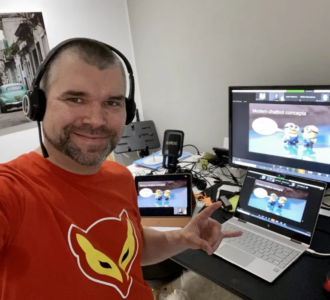 Mission control room with tools and backup devices at hand
Mission control room with tools and backup devices at hand
All worked brilliantly: no glitches in internet connection nor problems with the breakout rooms were experienced.
The previous week many video conferencing services were reported to have quality issues globally, due to vastly increased usage, traffic and therefore need for increased capacity. Furthermore, Zoom has had issues with zoom bombing and privacy. Also, as we have seen in Great Britain, security issues can occur even in the highest state level, if users are not careful (https://metro.co.uk/2020/03/31/boris-johnson-sparks-security-concerns-revealing-zoom-id-cabinet-meeting-12489236/ )
These security issues were noted when planning the Hackathon, but the risk was not evaluated high enough for the plans to be changed. First of all, in Hackathon there wasn’t any handling of confidential data. E.g. what comes to privacy, in the normal times, Universities of Applied Sciences in Finland are accessible for the public. Basically, anybody can walk in from the streets to follow the teaching session. Secondly, the likelihood of zoom bombing is still very small, and participants can be easily excluded from the call.
During the hackathon, LinkedIn and Twitter were used for communicating the actions for the public. Later, a news post was published on the site (https://www.3amk.fi/en/2020/04/03/first-virtual-hackathon-succeeded-beyond-expectations/).
Results: Innovative solution concepts by students
Participants reported that the results were good. Students from different nationalities and backgrounds (business management, business information technology, and others) worked in teams. Virtual implementation meant that students could participate from everywhere. For example, an exchange student from Germany had to travel back home early due to corona-situation, but he participated in the Hackathon, nevertheless.
“The hackathon yesterday was a great example of how studying in the times of corona can work. I was in Germany, but I still had the opportunity to listen to the great presentations from Google and Headai. I also believe that all teams accomplished a lot during those short hours and were able to present a really nice prototype”, he commented.
Prototypes that were created during the day were excellent – and inspired by the current situation: corona history quiz for kids-chatbot, corona meal helper-chatbot, smart city feedback-chatbot and a weather-based recommender by Zapier. Students applied the service design and user-centric design principles to highlight the value to users as a starting point. Concepts were further developed, documented and shared with other students a week after the hackathon.
Feedback & evaluation of the hackathon
Students gave their team presentations online at the end of the day. Participants were encouraged to give feedback to other teams. Coaches visited the breakout rooms during the teamwork sessions regularly to provide support and feedback during the process, and from their point of view, students were really engaged. Working in teams ensured that everyone contributed because of the social pressure. Even the students with less background on the topic seemed to be excited:
“All in all, it was a great experience and I loved “learning by doing” -approach. For someone completely new to the topic and without tech background, I felt proud at the end of the day when I was able to demonstrate with my team our working version of the educational chatbot”, one participant commented.
Although the work was made in teams, students were evaluated by their individual contribution and by the final deliverable.
Conclusions & lessons learned
What were the success factors behind the virtual hackathon?
The Hackathon was arranged online in a short time. This was possible because the organizers were creative and solution oriented, instead of being hopeless and cancelling or postponing the session. Mental flexibility was needed, and different online tools had been battle-tested for years way in advance. These surely affected the “can-do -attitude”.
Besides, the pedagogical model existed: Learning by Developing approach worked as a framework for the event and Laurea Digital Living Lab offered tools to implement virtual projects. Coaches had a vision about what works and enough prior experience that brought courage to organize something new.
Nobody knew everything deeply, which is common when it comes to complex technology projects. In practice, only one of the coaches knew how to use Zapier, and only two knew RPA. One person knew programming and another about the API-use cases. In conclusion, one person knew only one corner of the cube, and that was enough for the team effort. In addition, Headai experts were online a couple of times for more difficult technical questions about their APIs.
In addition to creativity, teachers had prior experience of a variety of pedagogical methods related to technology, online collaboration, sprints, hackathons and corporate training.
Let’s get back to the meme…
Mononen comments: “I have been trying to lure people into digital transformation path all my career, for the last 23 years. It’s been often slow and frustrating, like experienced by many other early adopters. I have seen dozens of digital transformation projects, coached hundreds of companies and entrepreneurs totalling thousands of people towards digital ways of working, e-learning and digital marketing. That’s why this corona-meme captures the essence, making me laugh and cry at the same time.”
So, who is leading your organisation’s digital transformation going forward: CEO, CTO or COVID-19?
References
- Mononen, A., Kortelainen, M., Hellgrén, A. & Laurea universities of applied sciences. (2016). Students as customers: Service process development for improved student’s customer experience at BusinessLab of Laurea University of Applied Sciences, Finland. Nova Science Publishers. (http://www.urn.fi/URN:NBN:fi:amk-2016091214176 )
- Raij, K. & Taatila, V. 2012. Philosophical Review of Pragmatism as a Basis for Learning by Developing Pedagogy. Educational Philosophy and Theory, Vol. 44, No.8.
- Trilling B. & Fadel C. 2009. 21st century skills, Learning for life in our times.
Internet Sources